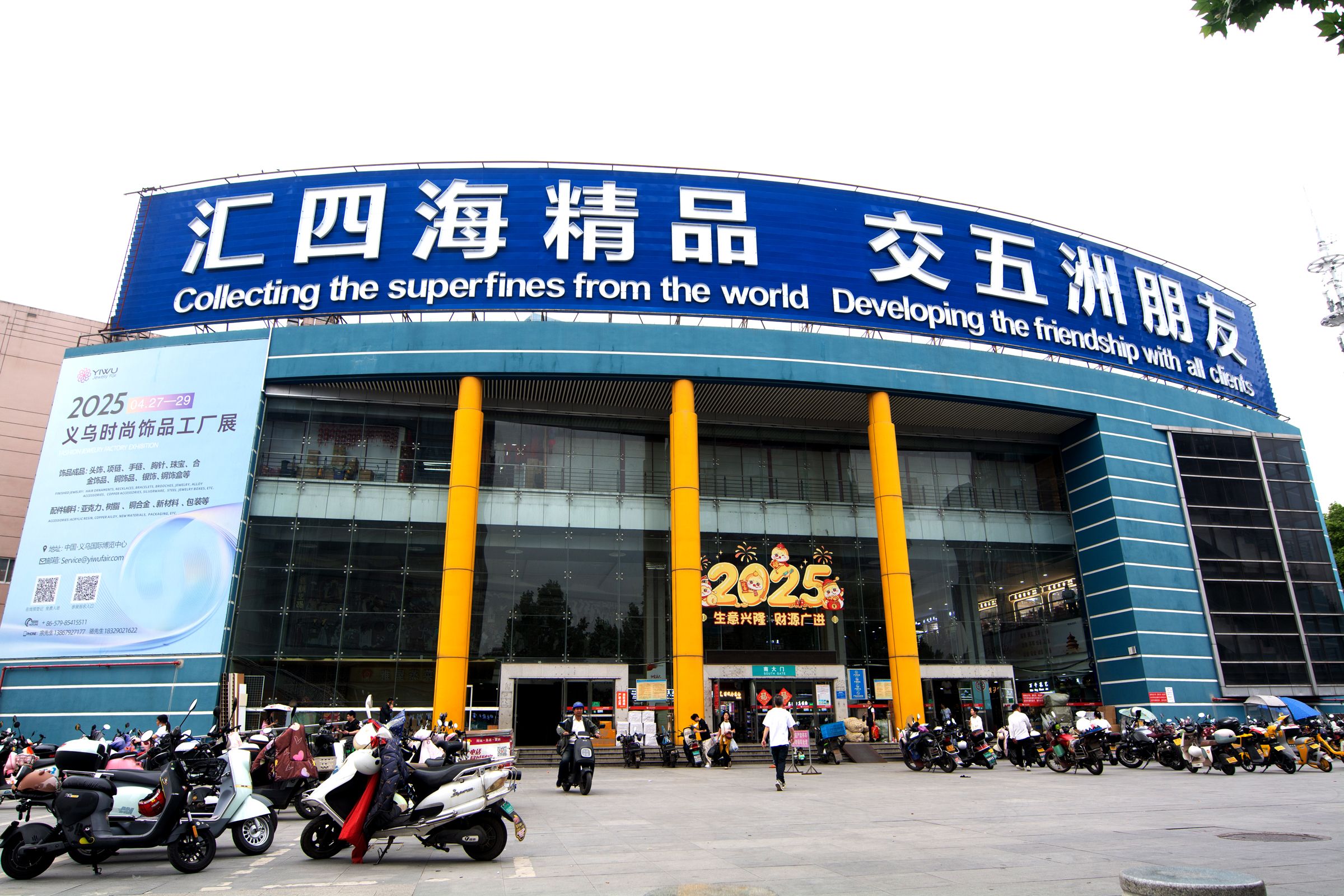While children are told stories about elves and reindeer, the truth is that hundreds of thousands of people work year-round to make sure Christmas feels magical. From factory employees in China stringing lights on artificial trees to dock workers unloading containers of toys, this vast labor force ensures Americans can choose from a wide selection of decorations and gifts each December. But all of that is in peril this year as President Donald Trump’s disruptive tariff policies threaten to halt a big chunk of global trade.
Across almost every industry, businesses that depend on international trade are waiting in agony as Trump’s tariff standoff with China continues. Some are pausing their orders, while others are scrambling to find alternative suppliers. The disruption, which has dragged on for almost a month, is particularly damaging to industries that run on strict seasonal production cycles, such as for holidays like Christmas. “If you miss this sales cycle, you have to wait the entire year. Nobody wants a Christmas tree after Christmas,” says Michael Shaughnessy, senior vice president of supply chains at Balsam Brands, a multinational holiday decor company.
Companies that sell Christmas ornaments, gifts, and toys tell WIRED that April is usually the time when retailers lock in their orders and manufacturing begins. If they can’t start making products soon, they will face a time crunch later in the year, higher shipping rates, and may potentially miss their sales window. As a result, US customers will likely see fewer options on store shelves and be forced to pay more for their usual Christmas purchases this year.
“Things will be more expensive and there will be fewer choices,” says Jim McCann, the founder of 1-800-Flowers, which sells a wide variety of holiday gifts, greeting cards, and food baskets. “Retailers won’t be forced to discount like they have in the past because there’ll be no reason to.”
The Clock Is Ticking
For people in the Christmas business, work starts for next year as soon as the holiday ends. Until recently, this supply chain was a well-oiled machine, with everyone carrying out their duty at the right time of the year, collectively building up to the grand festive finale.
Rick Woldenberg, CEO of educational toy manufacturer Learning Resources, gave WIRED a breakdown of the timeline: Placing orders and having factories manufacture the products takes three months, and then shipping them from China to the US takes another two. That means, if a company is aiming to have its inventory begin arriving at US warehouses by mid-September to begin preparing for the December holiday season, they really need to start working now, in April.
Earlier this month, Woldenberg sued the Trump administration over the tariffs, alleging the president overstepped his authority by introducing such broad import duties. “We are trying to stand up for ourselves and protect our rights,” he says. “We need help now. The sooner the better. We want them to stop.”
Woldenberg predicts that toy store shelves won’t necessarily be empty come Christmas, because retailers may scramble to find discontinued products or other replacements to fill the gap, but they won’t necessarily be the items customers are looking for. “That is when Americans are really going to find out what a terrible idea this has been,” he says. “We had this once-in-a-millennium amazing supply chain, and it’s being torn apart for no reason.”
Shaughnessy, whose company owns the premium artificial Christmas tree brand Balsam Hill, describes a timeline similar to Woldenberg’s: “In most years, right now we would be starting to ship as much product as possible, because over the next four, five months, we’d be looking to fill up our warehouses,” he says.
For now, the decorations industry is still waiting for the tariff situation to change, but the very latest cut-off time to ensure goods reach consumers by December would be the beginning of August, Shaughnessy says. If Trump misses that deadline, his company and many others will have missed the sales cycle this year.
But even if the tariffs are reduced or lifted before then, Shaughnessy says, he expects to pay more to transport his products, because every retail company will be competing for the same amount of shipping containers. In a normal year, shipping rates from China to the West Coast of the US usually costs less than $2,000 per container, but the current supply chain disruption is bringing back memories of the pandemic supply-chain shock, when shipping rates shot up over $20,000 per container right after trade resumed. “The system is like a steam locomotive. You can’t slow it down very quickly, and you also can’t speed it up very quickly,” Shaughnessy says.
Factory Shutdown
On the other side of the Pacific Ocean, the Chinese factories that make almost all of America’s Christmas products are also waiting anxiously for their clients to resume placing orders again. Three owners of artificial Christmas tree factories described the same situation to WIRED: US clients that typically place orders every year have either held off or canceled them entirely, leaving some factories with no business while others are struggling to find non-US buyers. All three owners asked to remain anonymous or use only their English names to protect their privacy.
“The clients that we had relationships with don’t want to cancel everything, so for some of them, we are shouldering the cost increases,” says Evan, owner of the company Heyuan Limei Tree and Light Technology. “Other clients are betting this policy won’t survive after June and things could go back to normal then.” He’s grateful that at least his factory is still running; two smaller ones close by have already furloughed their workers and shut down their machines for now.
At the China Import and Export Fair this week, one of the largest international trade shows in the world, buyers from the US and Europe made up just 10 percent of the total registered attendees, Evan says. In previous years, that number was usually about 40 percent.
“Clients usually place orders from January to March, and we ship out the products from April to August. To be honest, the production window for Christmas trees is not long,” says Jessica, the owner of a Christmas tree company in the city of Jinhua. The tariffs have also resulted in an unexpected windfall for one of Jessica’s clients. Last year, she says, the retailer missed out on most of the Christmas sales cycle because the products they ordered were delayed for an extended period at US customs. Those same trees that have been sitting in US warehouses for almost half a year are not subject to the tariffs, and may give the retailer a cost advantage over their competitors.
Jessica’s factory is right next door to Yiwu, the small Chinese city that has been the epicenter of the global Christmas merchandise industry since the 2000s and now supplies about 80 to 90 percent of the US market. Over the past few weeks, both domestic and international media outlets have flocked to Yiwu to check in with factories and traders, who expressed a mix of anxiety and optimism. Many are turning to clients in Europe, Latin America, and Russia, hoping other regions can help make up for the lack of American demand. Sometimes, that means changing the look of Santa Claus figurines to better reflect European instead of American tastes.
Magnus Marsden, a professor at the University of Sussex who led a five-year project looking at foreign trade in Yiwu, says that factories need to work together to blunt the negative impacts of the tariffs. The most important thing is to keep assembly lines operating, because without steady gigs, workers who migrated to Yiwu from more rural parts of China will likely go back home and be reluctant to return in the future. “What some companies are doing is giving some of their contracts to other places, to companies that are particularly invested in the American market, with the aim of making sure that they can continue to survive,” Marsden says.
Few Winners
The only businesses that have escaped the impacts of the tariffs—at least for now —are those that sell Christmas-themed products all year long.
“Many of our suppliers are still figuring out how they will be handling tariffs, and I’ve locked in tariff-free pricing for this year. The bigger concern will be for 2026 if the situation remains unchanged,” says Paul Brown, operations manager of Santa Claus House in North Pole, Alaska.
Debi Thomas, owner of the Los Angeles–area store Christmas Traditions, which has been in business for over 30 years, says she still has merchandise on hand from the past two or three years. “People can shop for items that have never been tariffed, and they are certainly going to be cheaper than what some are buying from retail stores now,” she says.
But Thomas is still expecting to raise the price of new products arriving as soon as May. Her store sources many handmade items from the Philippines and India, and those vendors have also started informing her that costs will go up somewhere between 10 to 17 percent if Trump’s blanket tariffs on the rest of the world remain in place.
As a family-owned small business, Thomas says she will have no choice but to pass down the price to consumers. For now, all she can do is wait for the tariff drama to end. “We wake up every morning and we say, ‘Oh please, let this be the day when the tariffs are canceled. Please, let this be a moment of clarity,’” she says.




